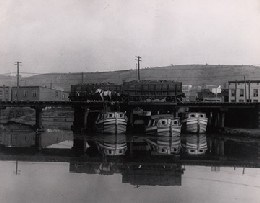
NPS Photo The seven-day trip from Cumberland to Georgetown was a long and demanding journey. Most of the family's eighteen-hour day was devoted to moving the cargo, mostly coal, down the canal. The hours on the quiet stretches between locks could be tedious, but encounters with other boats and locking through furnished the opportunity for all-too-brief exchanges with other canallers. Because the boat was designed for cargo, those aboard had to content themselves with the smallest of accommodations: a 12'x12' cabin was the family's quarters for the trip. Although small, the cabin contained all the necessities: a coal burning stove, bunk beds with hay mattresses, a table, and a small cupboard for supplies. The boats also included a stable for the mules and a hay storage area. Lock tenders were also an important part of canal operations. Living in rent free houses just beside their locks, the lockkeepers worked "dawn to dawn", constantly on duty to lock through approaching boats. The lock tender listened for the boatman's horn and his cry of "Hey-y-y-y Lock!" which signaled the canal was, at any hour, hard at work. Mother Nature's wrath took its toll on the canal over the years. Repeated flooding closed the canal for months, even whole seasons. Furthermore, the canal could not match the speed or dependability of its rival, the Baltimore & Ohio Railroad. The railroad, which stretched west many years ahead of the canal, had captured almost all of the canal's trade by 1924 when another devastating flood struck. This time, no repairs were made and the canal ceased commercial operations. Serving the Potomac Valley The Chesapeake and Ohio Canal brought a variety of benefits to the Potomac River Valley, an area that was predominantly agricultural. Construction created many jobs, both skilled and unskilled, but there were not enough workers around to fill them all. As a result, wages went up, and many new workers came from other regions or from other countries. The building of the C & O helped other people in the region. Landowners profited directly from the sale of their property to the canal company and indirectly because surrounding property increased in value. Others established construction firms that produced good profits because building materials were in high demand. Workers needed food and shelter, which created more jobs local farmers and builders. The canal continued to help the region's development after it opened. It lowered the cost of transportation, which allowed industries and farmers to ship their goods farther. Cheaper freight rates also made it possible to bring in more goods: farmers, for example, could now import fertilizer and thereby rejuvenate soil that had lost most of its nutrients. The owners of and workers in the coal mines near Cumberland were among the biggest beneficiaries of the canal. Competition between the B & O and the C & O for cargo reduced freight rates; as costs fell, the profits for mine owners and operators increased. Georgetown shippers who carried the coal to New England textile mills and iron-smelting operations made substantial profits as well. Other canal-related industries supported many families in the Potomac Valley. Water flowing through the canal powered new grain mills, foundries, and textile factories, all of which produced still more jobs. Some members of the construction teams took on the positions of canal boat captains and crew, while others found jobs as lock tenders and maintenance workers. As boat building and repair became a profitable occupation, dry docks were constructed in various locations along the canal to provide places for these repairs. Many people operated grocery and feed stores along the waterway. Merchants provided provisions for boatmen, their families, and their mules. The pay the workers received from the canal company was usually spent in the neighboring towns and cities along the canal. Competition from the B & O Railroad and destructive floods eventually put the canal out of business. Although it never provided great fortunes for its investors, the canal did serve the Potomac Valley for nearly a century and stimulated growth in the region. |
Last updated: February 8, 2018
